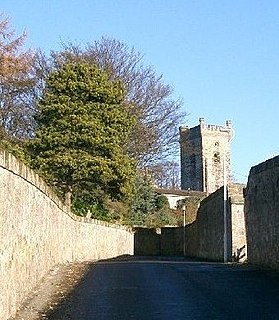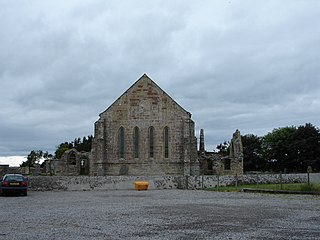
Glenluce Abbey, near to Glenluce, Scotland, was a Cistercian monastery called also Abbey of Luce or Vallis Lucis and founded around 1190 by Rolland or Lochlann, Lord of Galloway and Constable of Scotland. Following the Scottish Reformation in 1560, the abbey fell into disuse.

The Abbot and then Commendator of Melrose was the head of the monastic community of Melrose Abbey, in Melrose in the Borders region of Scotland. The abbots of the earlier Northumbrian foundation from Lindisfarne are not included here. The second abbey was founded in 1136 on the patronage of David I, King of Scots, by Cistercian monks from Rievaulx Abbey, Yorkshire. Control of the abbey was secularized in the 16th century and after the accession of James Stewart, the abbey was held by commendators. The last commendator, James Douglas of Lochleven, resigned the abbacy to William Douglas, 6th Earl of Morton in December 1606, and the abbey itself to the king in 1608. The abbey was then erected into a secular lordship for viscount Haddington, John Ramsay, who in 1609 was created "Lord Melrose". Lochleven however resumed the title of commendator in 1613 until his death in 1620.

The Abbot and then Commendator of Culross was the head of the monastic community of Culross Abbey, Fife, Scotland. The abbey was founded in 1218 on the patronage of Maol Choluim I, Earl of Fife by Cistercian monks from Kinloss Abbey, Moray. Control of the abbey was secularized in the 16th century and after the accession of James Stewart, the abbey was held by commendators. The number of monks under the abbot had also declined by the 16th century, there being only 15 monks by 1557.

The Prior, then Abbot and then Commendator of Dunfermline was the head of the Benedictine monastic community of Dunfermline Abbey, Fife, Scotland. The abbey itself was founded in 1128 by King David I of Scotland, but was of earlier origin. King Máel Coluim mac Donnchada had founded a church there with the help of Benedictines from Canterbury. Monks had been sent there in the reign of Étgar mac Maíl Choluim and Anselm had sent a letter requesting that Étgar's brother and successor King Alaxandair mac Maíl Coluim protect these monks. By 1120, when Alaxandair sent a delegation to Canterbury to secure Eadmer for the bishopric of St Andrews, there is a Prior of the Dunfermline monks by the name of Peter leading the delegation. Control of the abbey was secularized in the 16th century and after the accession of James Stewart in 1500, the abbey was held by commendators. In the second half of the 16th century, the abbey's lands were being carved up into lordships and it was finally annexed to the crown in July, 1593.
The Abbot of Coupar Angus was the head of the monastic community and lands of Coupar Angus Abbey, on the boundary between Angus and Gowrie in Scotland. The abbot David Bane was granted the mitre in 1464. The following are a list of abbots and commendators.
The Prior of Whithorn was the head of the monastic community at Whithorn Priory, attached to the bishopric of Galloway at Whithorn. It was originally an Augustinian establishment, but became Premonstratensian by the time of the second or third known prior. As most of the priors of Whithorn appear to be native Galwegian Gaels, it would appear that most priors before the 16th century at least were drawn from region, something unusual in medieval Scotland. The following is a list of abbots and commendators.
The Abbot of Balmerino was the head of the Cistercian monastic community and lands of Balmerino Abbey, Fife, founded in 1227 x 1229 by monks from Melrose Abbey with the patronage of Ermengarde de Beaumont and King Alexander II of Scotland. The following are a list of abbots and commendators.
The Abbot of Dundrennan was the head of the Cistercian monastic community of Dundrennan Abbey, Galloway. It was founded by Fergus of Galloway in 1142. Dundrennan was a large and powerful monastery in the context of the south-west. It became secularised and protestantised in the 16th century. In 1606 it was finally turned into a secular lordship in for John Murray of Lochmaben, afterwards earl of Annandale.
The Abbot of Crossraguel was the leader of the Cluniac monastic community of Crossraguel Abbey, near Maybole in Carrick, south-west Scotland. It was founded in 1260s by Donnchadh mac Gille Brigte, earl of Carrick with monks from Paisley Abbey. Owing to the lack of surviving records and its distance from the core of Lowland Scotland in the western Gàidhealtachd, few of the abbots are known by name. The abbots were replaced by commendators in the 16th century, and the abbey came to an end when its lands were taken over by the bishops of Dunblane in 1617.

The Abbot of Fearn was the head of the Premonstratensian monastic community of Fearn Abbey, Easter Ross, Scotland. The Abbey was founded by canons from Whithorn Priory in Galloway, with the patronage of Fearchar mac an t-Sagairt, mormaer/earl of Ross. The foundation took place in the 1220s, according to the two distinct foundation dates given in the sources, either in 1221 or in 1227. Until about 1238, the Abbey was located at Fearn, near Edderton, but it was moved to the Tarbat parish in that year and known thereafter as "nova Furnia". Despite the fact that the head of Whithorn Priory was a prior and Fearn an abbot, Fearn seems to have remained subordinate to Whithorn until at least the end of the 14th century, and even in 1440 Abbot Fionnlagh II was confirmed by the prior of Whithorn.The reason for this is that Whithorn was a cathedral priory; the nominal head of its community was the bishop, but its actual head was the prior, as was the common use in England at places like Durham and Carlisle, but this was not usual in Scotland. In these circumstances the cathedral prior had the same rights as an ordinary abbot.
The Abbot of Holyrood was the head of the Augustinian monastic community of Holyrood Abbey, now in Edinburgh. The long history of the abbey came to a formal end in July 1606 when the parliament of Scotland turned the abbey into a secular lordship for the last commendator, John Bothwell. The following is a list of abbots and commendators:
The Abbot of Soulseat was the head of the Premonstratensian monastic community of Soulseat Abbey in Galloway. The following is a list of abbots and commendators:
The Abbot of Sweetheart was the head of the Cistercian monastic community of Sweetheart Abbey, in the ancient province of Galloway in the present area of Dumfries and Galloway, founded by monks from Dundrennan Abbey with the patronage of Derbhfhorghaill inghean Ailein, Lady of Galloway, about 1275. The following are a list of abbots and commendators.
The Abbot of Tongland was the head of the Premonstratensian monastic community of Tongland Abbey in the historical county of Kirkcudbrightshire in Dumfries and Galloway. The following is a list of abbots and commendators:
The Abbot of Cambuskenneth or Abbot of Stirling was the head of the Arrouaisian (Augustinian) monastic community of Cambuskenneth Abbey, near Stirling. The long history of the abbey came to a formal end when the abbey was turned into a secular lordship for the last commendator, Alexander Erskine.
The Prior of Coldingham was the head of the Benedictine monastic community of Coldingham Priory in Berwickshire. Coldingham Priory was founded in the reign of David I of Scotland, although his older brother and predecessor King Edgar of Scotland had granted the land of Coldingham to the Church of Durham in 1098, and a church was constructed by him and presented in 1100 AD. The first prior is on record by the year 1147, although an earlier foundation is almost certain. The monastic cell was a dependent of Durham until the 1370s, and in 1378 King Robert II of Scotland expelled the Durham monks; for the following century the cell had two priors, one chosen by Durham and one chosen by the Scots. It became a dependent of Dunfermline Abbey. It was subject to increasingly secular control from the late 15th century into the 16th century. The following is a list of priors and commendators:
The Archdeacon of Galloway was the only archdeacon in the medieval Diocese of Galloway (Whithorn), acting as a deputy of the Bishop of Galloway. The following is a list of archdeacons:

Gilbert was a 13th-century Cistercian monk, abbot and bishop. His first appearance in the sources occurs under the year 1233, for which year the Chronicle of Melrose reported that "Sir Gilbert, the abbot of Glenluce, resigned his office, in the chapter of Melrose; and there he made his profession". It is not clear why Gilbert really did resign the position of Abbot of Glenluce, head of Glenluce Abbey in Galloway, in order to become a mere brother at Melrose Abbey; nor is it clear for how long Gilbert had been abbot, though his latest known predecessor is attested last on 27 May 1222. After going to there, Gilbert became the Master of the Novices at Melrose.
The Prior of Perth was the head of Perth Charterhouse, the Carthusian monastic house located near Perth. It was founded in 1429, and finally suppressed in 1602. The following is a list of priors and prior-commendators:





